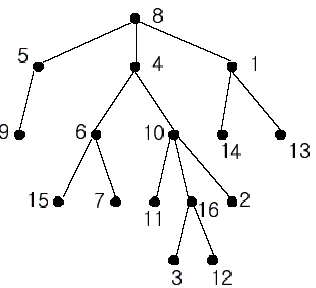POJ 1330 LCA裸题~
Description

In the figure, each node is labeled with an integer from {1, 2,...,16}. Node 8 is the root of the tree. Node x is an ancestor of node y if node x is in the path between the root and node y. For example, node 4 is an ancestor of node 16. Node 10 is also an ancestor of node 16. As a matter of fact, nodes 8, 4, 10, and 16 are the ancestors of node 16. Remember that a node is an ancestor of itself. Nodes 8, 4, 6, and 7 are the ancestors of node 7. A node x is called a common ancestor of two different nodes y and z if node x is an ancestor of node y and an ancestor of node z. Thus, nodes 8 and 4 are the common ancestors of nodes 16 and 7. A node x is called the nearest common ancestor of nodes y and z if x is a common ancestor of y and z and nearest to y and z among their common ancestors. Hence, the nearest common ancestor of nodes 16 and 7 is node 4. Node 4 is nearer to nodes 16 and 7 than node 8 is.
For other examples, the nearest common ancestor of nodes 2 and 3 is node 10, the nearest common ancestor of nodes 6 and 13 is node 8, and the nearest common ancestor of nodes 4 and 12 is node 4. In the last example, if y is an ancestor of z, then the nearest common ancestor of y and z is y.
Write a program that finds the nearest common ancestor of two distinct nodes in a tree.
Input
Output
Sample Input
2
16
1 14
8 5
10 16
5 9
4 6
8 4
4 10
1 13
6 15
10 11
6 7
10 2
16 3
8 1
16 12
16 7
5
2 3
3 4
3 1
1 5
3 5
Sample Output
4
3
最近在复习一些暑假集训时候学到的一些数据结构,这次的主题是LCA(最近公共祖先),找出一棵树里边任意两个节点的最近公共祖先节点(这个称呼不太科学?),这是一道全裸的LCA的题目,有两种解决思路
方法一:对于每次查询的两个节点,先让两个节点上升到同一个深度的地方,然后两个节点在同时上升,直到两个节点相遇为止,相遇的点即为最近公共祖先。
方法二:先让某个节点一直往上走一直走到根节点,并开一个数组记录这个路径,让后再让另一个节点往上走,直到与前一个节点产生的路径相交为止,那么这个交点也是两个节点的最近公共祖先啦~ 方法1的AC代码:
/*********************************
Author: jusonalien
Email : jusonalien@qq.com
school: South China Normal University
Origin:
*********************************/
#include <cstdio>
#include <vector>
#include <cstring>
using namespace std;
const int maxn = ;
vector<int>G[maxn];
int depth[maxn],father[maxn];
int root,n;
void dfs(int v,int p,int d){//通过dfs构造出一棵树,并且记录每个节点的深度,这个很重要!
depth[v] = d;
for(int i = ;i < G[v].size();++i){
if(G[v][i] != p) dfs(G[v][i],v,d+);
}
return ;
}
int lca(int u,int v){
while(depth[u] > depth[v]) u = father[u];
while(depth[v] > depth[u]) v = father[v];
while(u != v){
u = father[u];
v = father[v];
}
return u;
}
void init(){
memset(depth,,sizeof(depth));
memset(father,-,sizeof(father));
for(int i = ;i <= n;++i) G[i].clear();
}
void print(){//调试代码
for(int i = ;i <= n;++i) printf("%02d ",father[i]);
puts("");
for(int i = ;i <= n;++i) printf("%02d ",depth[i]);
puts("");
}
int main(){
int cas;
int a,b;
scanf("%d",&cas);
while(cas--){
scanf("%d",&n);
init();
for(int i = ;i < n;++i){
scanf("%d%d",&a,&b);
father[b] = a;
G[a].push_back(b);
}
for(int i = ;i <= n;++i)
if(father[i] == -){
root = i;break;
}
dfs(root,-,);
//print();
scanf("%d%d",&a,&b);
printf("%d\n",lca(a,b));
}
return ;
}
方法2的AC代码:
#include <cstdio>
#include <cstring>
using namespace std;
int const maxn = +;
int fa[maxn];
bool vis[maxn];
int n;
int main()
{
int T;
scanf("%d",&T);
while(T--)
{
int u,v;
scanf("%d",&n);
memset(vis,,sizeof(vis));
memset(fa,,sizeof(fa));
for(int i=;i<n;++i)
{
scanf("%d%d",&u,&v);
fa[v]=u;
}
scanf("%d%d",&u,&v);
do
{
vis[u]=true;
u=fa[u];
}while(u!=);
do
{
if(vis[v])
{
printf("%d\n",v);
break;
}
v=fa[v];
}while(v!=);
}
return ;
}
个人觉得,方法1对于同一棵树上的大规模查询的效率要比方法2要高,并且当查询的节点大都在树的底层的时候,方法2会产生很多不必要的查询,也会产生较多的浪费(并且个人觉得方法1的代码更加优美?
Ps:这里有一份很不错的关于RMQ和LCA的学习资料介绍,请猛戳此处 选自农夫三拳。
POJ 1330 LCA裸题~的更多相关文章
- JZOJ5883【NOIP2018模拟A组9.25】到不了——动态LCA裸题
题目描述 Description wy 和 wjk 是好朋友. 今天他们在一起聊天,突然聊到了以前一起唱过的<到不了>. "说到到不了,我给你讲一个故事吧." &quo ...
- poj 1330 LCA
#include<cstdio> #include<iostream> #include<algorithm> #include<cstring> #i ...
- poj 1330 LCA (倍增+离线Tarjan)
/* 先来个倍增 */ #include<iostream> #include<cstring> #include<cstdio> #define maxn 100 ...
- POJ 3264 RMQ裸题
POJ 3264 题意:n个数,问a[i]与a[j]间最大值与最小值之差. 总结:看了博客,记下了模板,但有些地方还是不太理解. #include<iostream> #include&l ...
- poj 1330 LCA最近公共祖先
今天学LCA,先照一个模板学习代码,给一个离线算法,主要方法是并查集加上递归思想. 再搞,第一个离线算法是比较常用了,基本离线都用这种方法了,复杂度O(n+q).通过递归思想和并查集来寻找最近公共祖先 ...
- POJ 1330 LCA最近公共祖先 离线tarjan算法
题意要求一棵树上,两个点的最近公共祖先 即LCA 现学了一下LCA-Tarjan算法,还挺好理解的,这是个离线的算法,先把询问存贮起来,在一遍dfs过程中,找到了对应的询问点,即可输出 原理用了并查集 ...
- POJ.1330 Nearest Common Ancestors (LCA 倍增)
POJ.1330 Nearest Common Ancestors (LCA 倍增) 题意分析 给出一棵树,树上有n个点(n-1)条边,n-1个父子的边的关系a-b.接下来给出xy,求出xy的lca节 ...
- POJ 1330 Nearest Common Ancestors 倍增算法的LCA
POJ 1330 Nearest Common Ancestors 题意:最近公共祖先的裸题 思路:LCA和ST我们已经很熟悉了,但是这里的f[i][j]却有相似却又不同的含义.f[i][j]表示i节 ...
- POJ - 1330 Nearest Common Ancestors(dfs+ST在线算法|LCA倍增法)
1.输入树中的节点数N,输入树中的N-1条边.最后输入2个点,输出它们的最近公共祖先. 2.裸的最近公共祖先. 3. dfs+ST在线算法: /* LCA(POJ 1330) 在线算法 DFS+ST ...
随机推荐
- UML系统建模学习
什么是UML系统建模 UML系统建模是一种与面向对象软件开发密切相关的建模方法.通过建造模型可以验证建造事物的可行性.UML是一种统一建模语言,它的全称是(Unified Method Languag ...
- Xcode报referenced from错误的总结
一.库文件丢失 如果提示的文件是库文件,比如说是sdk的文件,有可能是就是丢失,或者没有引用到该工程. 1.点击这个.a库,或者framework,看右边的target里面是否引用到了当前的targe ...
- 慕课笔记利用css进行布局【一列布局】
<html> <head> <title>一列布局</title> <style type="text/css"> bo ...
- 可并堆试水--BZOJ1367: [Baltic2004]sequence
n<=1e6个数,把他们修改成递增序列需把每个数增加或减少的总量最小是多少? 方法一:可以证明最后修改的每个数一定是原序列中的数!于是$n^2$DP(逃) 方法二:把$A_i$改成$A_i-i$ ...
- Linux下C编程入门(7)
Linux下项目同步工具介绍git和github 一.远程仓库工具github 1. 一.本地操作工具git 1.
- vim fulerformat的设置
在vim中设置选项,有注释很容易明白: set laststatus=1 "2总显示最后一个窗口的状态行,1窗口多于一个时显示最后一个窗口的状态行,0不显示最后一个窗口的状态行 fulerf ...
- C#高级编程第9版 第一章 .NET体系结构 读后笔记
.NET的CLR把源代码编译为IL,然后又把IL编译为平台专用代码. IL总是即时编译的,这一点的理解上虽然明白.当用户操作C#开发的软件时,应该是操作已经编译好的程序.那么此时安装在客户机上的程序是 ...
- hdu - 1689 Just a Hook (线段树区间更新)
http://acm.hdu.edu.cn/showproblem.php?pid=1698 n个数初始每个数的价值为1,接下来有m个更新,每次x,y,z 把x,y区间的数的价值更新为z(1<= ...
- Codeforces 651D Image Preview【二分+枚举】
题意: 若干张照片,从头开始可以向左右两边读,已经读过的不需要再读,有的照片需要翻转,给定读.滑动和翻转消耗的时间,求在给定时间内最多能读多少页? 分析: 首先明确,只横跨一次,即先一直读一边然后再一 ...
- JSP页面不支持EL表达式的解决方法
JSP页面不支持EL表达式的问题就出在新建项目时web.xml的声明上. web.xml声明部分一般分为如下版本的xsd: web-app_2_2.xsd web-app_2_3.xsd web-ap ...
